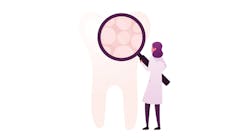Untreated periodontitis and COVID-19: What is the evidence? Part 1 of 3
Prioritizing the health of the immune system has never been more important than during a viral pandemic such as COVID-19, the disease caused by severe acute respiratory syndrome coronavirus 2 (SARS-CoV-2). Patients know this, and they’re well primed to hear about ways they can boost their immunity. Of course, there are recommendations such as dietary supplements, good nutrition, adequate sleep, increased physical activity, and stress management. But how about addressing chronic infections that compromise immunity?
Could this include untreated periodontitis? If only the periodontal microbiota could whisper the answer. Like so many things in this pandemic, we just don’t know. That said, my answer is “maybe.” I realize there will be those who disagree with my reasoning here. As in any scholarly debate, I welcome their alternative views.
No one has investigated whether treatment of periodontitis specifically enhances immunity. However, what we do have is mounting evidence that many persistent infections can alter immunity to unrelated pathogens.1 These are referred to as chronic bystander infections, which may also exert another negative impact—vaccines for unrelated illnesses may not be as effective in people who have persistent infections.1
The possibility that untreated periodontitis may have a negative impact on the immune system or exacerbate complications of a viral influenza conveys to oral health-care providers a critical responsibility. More than ever before, we must be vigilant in diagnosing and treating periodontitis. Equally important is implementing the new therapeutic target established in the 2017 World Workshop on the Classification of Periodontal and Peri‐Implant Diseases and Conditions:2 remission or control of disease activity in a reduced periodontium after initial therapy. Our work has never been more important.
In parts one and two of this three-part series, I’ll explore two biologically plausible mechanisms that support the possibility that untreated periodontitis could dysregulate the immune system to the extent that it increases susceptibility to viral influenzas, and/or increases the severity of their complications. In part three, I’ll discuss various diagnostic and therapeutic strategies that target periodontal disease activity.
Cytokine storm
The first hypothetical mechanism is associated with a rogue response of the immune system to SARS-CoV-2, or what is medically described as a cytokine storm. This phenomenon has the capacity to cause more damage than the virus itself.
Cytokines are short-lived proteins that work as intercellular chemical messengers, and their production is a necessary part of the innate immune system. As cell-signaling molecules, their role in the functional immune system is to support cell-to-cell communication and stimulate other immune system cells to move toward sites of inflammation, infection, and trauma to clear foreign or unwelcome agents. One way of looking at it is that cytokines signal to the immune system, “Wake up, it’s time to start doing your job.”
Various assaults on the body, including influenza, pneumonia and sepsis, can trigger an excessively robust release of cytokines, specifically TNFα, IL-1β, IL-6, and IL-8, flooding the body with inflammation. Vascular permeability increases, and sepsis paves the way to multiorgan shutdown. This includes the heart, kidneys, brain, liver, and significantly so, the lungs, placing patients at risk for secondary coinfection leading to pneumonia. Of note, there is in-vitro evidence that Porphyromonas gingivalis, a particularly virulent periodontal pathogen, has the capacity to damage the vasculature.3
Cytokine storms are not unique to COVID-19. They have been implicated in influenza A H5N1, SARS-CoV,4,5 and influenza A H1N1, the Spanish flu pandemic of 1918, which resulted in an estimated 50 million deaths, making it one of the deadliest pandemics in human history.6,7 In COVID-19 patients, the levels of many proinflammatory cytokines have been elevated, with even higher levels in those who are critically ill.8 Levels of IL-6 were especially high in nonsurvivors of the original outbreak in Wuhan.9
Secondary infection
As pulmonary function decreases, the risk for secondary bacterial coinfection, such as Streptococcus pneumoniae, increases. This causes a reduction in blood oxygen levels, requiring assisted ventilation, which sets the stage for acute respiratory distress syndrome (ARDS), one of the most frequently observed complications and causes of death associated with COVID-19. This eventuates long-term ventilation in intensive care units (ICUs), which may last 16 days or longer, with significant influence on survivability.
High bacterial load of the oral cavity also contributes to the risk for ventilator-associated pneumonia. Notably, a retrospective analysis of data from the first outbreak of SARS-CoV-2 in Wuhan, China, reported that sepsis was the most frequently observed complication, with respiratory failure and ARDS as close seconds.10 In Wuhan, among those COVID-19 patients who were admitted to the hospital, about 42% developed ARDS, and of those patients, about 52% died.11
During this first outbreak in Wuhan, half of the nonsurvivors experienced secondary infection. It was further reported that 31% of patients who required mechanical ventilation developed ventilator-associated pneumonia.10 The diagnosis of secondary infection was made when there were signs of pneumonia and a positive culture of a new pathogen isolated from specimens from the lower respiratory tract.
These statistics align with a recent report of MacIntyre and colleagues12 who conducted a systematic review to estimate the prevalence of pneumonia and secondary infections during the 2009 pandemic of influenza A (H1N1). They found that secondary bacterial infection was identified in almost one in four patients, with S. pneumoniae being the most common infection. Just like COVID-19, bacterial complications, specifically pneumonia, had serious consequences including ICU admission and death.
It’s been estimated that one in seven patients with COVID-19 will develop secondary infection while hospitalized.10 Another study reported that only about 50% of deaths were due to the original viral infection, the other 50% were due to postviral secondary infections.13
Periodontitis and cytokine storm
So how might this be related to untreated periodontitis? Consider the following: the same cytokines mentioned above (TNFα, IL-1β, IL-6, and IL-8) are also involved with the inflammatory process in the pathogenesis and progression of periodontitis (figure 1). In addition to their local effect, these cytokines are also vascularly disseminated throughout the body, along with periodontal bacteria capable of evading host defenses. This increases inflammation in organs distant to the oral cavity, including the lungs, where secondary bacterial coinfection, associated with periodontitis, can seed pulmonary tissue. Could it be that this additional “dumping” of cytokines contributes to the storm already raging in the body of a COVID-19 patient (figure 1), ramping up the severity of the disease and/or exacerbating complications of secondary coinfections? Although this has not been studied, hypothetically, it’s plausible.
The ability of viral influenza infections to disrupt the respiratory tract by direct pathogenic effects has been recognized for many years.14 This then predisposes individuals to bacterial secondary coinfection. Furthermore, the risk for exposure to secondary bacterial infections significantly increases when high-risk individuals end up in critical care for long periods of time. Beyond the first data from Wuhan, it’s been widely reported that a significant number of hospitalized COVID-19 patients who have had or who continue to develop secondary bacterial coinfections such as bacterial pneumonia and sepsis will require ventilator intubation or extracorporeal membrane oxygenation. And we know, the longer these patients stay on ventilators, the greater the risk for more severe complications and death.15
Equally as important to consider is this fact: bacterial pathogens in the respiratory tract may predispose individuals to influenza and other viral infections.16 This leads me to propose a second hypothetical mechanism: the interaction between bacteria and viruses in infection and immunity (i.e., how bacteria and viruses can influence the infectivity of each other). In part two of this series, we’ll explore the plausibility of this second mechanism of predisposition to viral infections of the respiratory tract.
If only the periodontal microbiota could talk, indeed. The possibility that untreated periodontitis, as a chronic disease, could influence susceptibility to a viral influenza or exacerbate its complications is an idea ripe for scientific investigation. I hope someone tackles this. In the meantime, during this unprecedented time of unknowns and the nebulous science that surrounds this deadly virus, let’s do everything we can to help our patients bolster their immune systems. I believe this means making sure our patients are periodontally healthy. Comments are welcome.
Disclosure: Florida Probe and Perio Protect provided unrestricted educational grants to Casey Hein for her research of this subject and writing of this article.
References
- Stelekati E, Wherry EJ. Chronic bystander infections and immunity to unrelated antigens. Cell Host Microbe. 2012;12(4):458-469. doi:10.1016/j.chom.2012.10.001
- Lang NP, Bartold PM. Periodontal health. J Periodontol. 2018;89 Suppl 1:S9-S16. doi:10.1002/JPER.16-0517
- Farrugia C, Stafford GP, Potempa J, et al. Mechanisms of vascular damage by systemic dissemination of the oral pathogen Porphyromonas gingivalis. FEBS J. 2020;10.1111/febs.15486. doi:10.1111/febs.15486
- Wong JP, Viswanathan S, Wang M, Sun LQ, Clark GC, D’Elia RV. Current and future developments in the treatment of virus-induced hypercytokinemia. Future Med Chem. 2017;9(2):169-178. doi:10.4155/fmc-2016-0181
- Liu Q, Zhou YH, Yang ZQ. The cytokine storm of severe influenza and development of immunomodulatory therapy. Cell Mol Immunol. 2016;13(1):3-10. doi:10.1038/cmi.2015.74
- Rosenwald MS. History’s deadliest pandemics, from ancient Rome to modern America. Washington Post. April 7, 2020. https://www.washingtonpost.com/graphics/2020/local/retropolis/coronavirus-deadliest-pandemics/
- Gagnon A, Miller MS, Hallman SA, et al. Age-specific mortality during the 1918 influenza pandemic: unravelling the mystery of high young adult mortality. PLoS One. 2013;8(8):e69586. doi:10.1371/journal.pone.0069586
- Schett G, Sticherling M, Neurath MF. COVID-19: risk for cytokine targeting in chronic inflammatory diseases? Nat Rev Immunol. 2020;20(5):271-272. doi:10.1038/s41577-020-0312-7
- Tay MZ, Poh CM, Rénia L, MacAry PA, Ng LFP. The trinity of COVID-19: immunity, inflammation and intervention. Nat Rev Immunol. 2020;20(6):363-374. doi:10.1038/s41577-020-0311-8
- Zhou F, Yu T, Du R, et al. Clinical course and risk factors for mortality of adult inpatients with COVID-19 in Wuhan, China: a retrospective cohort study. Lancet. 2020;395(10229):1054-1062. doi:10.1016/S0140-6736(20)30566-3
- Wu C, Chen X, Cai Y, et al. Risk factors associated with acute respiratory distress syndrome and death in patients with coronavirus disease 2019 pneumonia in Wuhan, China. JAMA Intern Med. 2020;180(7):1-11. doi:10.1001/jamainternmed.2020.0994
- MacIntyre CR, Chughtai AA, Barnes M, et al. The role of pneumonia and secondary bacterial infection in fatal and serious outcomes of pandemic influenza a(H1N1)pdm09. BMC Infect Dis. 2018;18(1):637. doi:10.1186/s12879-018-3548-0
- Beusekom MV. Old age, sepsis tied to poor COVID-19 outcomes, death. Center for Infectious Disease Research and Policy. March 10, 2020. Accessed July 25, 2020. www.cidrap.umn.edu/news-perspective/2020/03/old-age-sepsis-tied-poor-covid-19-outcomes-death
- Taubenberger JK, Morens DM. The pathology of influenza virus infections. Annu Rev Pathol. 2008;3:499-522. doi:10.1146/annurev.pathmechdis.3.121806.154316
- Schacht O. COVID-19 patients need to be tested for bacteria and fungi, not just the coronavirus. Scientific American. April 16, 2020. Accessed July 25, 2020. https://blogs.scientificamerican.com/observations/covid-19-patients-need-to-be-tested-for-bacteria-and-fungi-not-just-the-coronavirus/
- Madhi SA, Klugman KP; Vaccine Trialist Group. A role for Streptococcus pneumoniae in virus-associated pneumonia. Nat Med. 2004;10(8):811-813. doi:10.1038/nm1077
Casey Hein, MBA, BSDH, RDH, is an internationally recognized speaker and extensively published author with over 40 years’ experience as a dental hygienist in private practice, public health, education, and government. She first began speaking about periodontal-systemic links in 2003 and founded the first publication on oral-systemic science, called Grand Rounds in Oral-Systemic Medicine. She is a pioneer in implementation of periodontal-systemic science, medical-dental collaboration, and providing primary-care services traditionally delivered by physicians and nurses in dental offices. Contact her at caseyhein.com.








